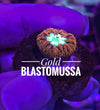The Angular Flasher Wrasse, also known as the Royal Flasher Wrasse, is a vibrantly-colored species of flasher wrasse originating from the Philippines and Northern Indonesia. Typically found near sheltered reefs rich with corals and algae, the Angular Flasher Wrasse occurs in small groups comprised mostly of females. As its alternate common name "Royal Flasher Wrasse" suggests, the Angular Flasher Wrasse is easily distinguished by its elongated and sharply angular dorsal and anal fins. The male Angular Flasher Wrasse also lacks dorsal filaments typical of many other species of flasher wrasse.
The Angular Flasher Wrasse demonstrates sexual dichromatism, meaning the coloration of the female will be notably different and subdued in comparison to the brilliant coloration of the male Angular Flasher Wrasse. When courting females, the male Angular Flasher Wrasse will display its brilliantly colored fins in an attempt to persuade its potential mate. Interestingly, the coloration of the Angular Flasher Wrasse can vary significantly depending on the fish's mood.
The Angular Flasher Wrasse is a very peaceful and active fish that will bring both color and movement to a fish-only or reef aquarium. A well-filtered established marine aquarium, 55 gallons in size or larger that is generously aquascaped with rockwork provides an excellent home. The Angular Flasher Wrasse will not bother any corals or invertebrates making it the perfect fish for the reef aquarium. Typically, a single male Royal Flasher Wrasse can be kept with a group of females that is introduced prior to or at the same time as the male. Similar to other flasher wrasses, the Angular Flasher Wrasse likes to jump, so a tight fitting canopy is essential.
The diet of the Angular Flasher Wrasse should include vitamin-enriched frozen mysis shrimp, vitamin enriched frozen brine shrimp, and other meaty foods along with a high quality marine flake and marine pellet food.
Approximate Purchase Size: Small: 1" to 2"; Medium: 2" to 3"; Large 3" to 4"
Note: Due to variations within species, your item may not look identical to the image provided. Approximate size range may also vary between individual specimen.
Credits: https://www.liveaquaria.com/




































































